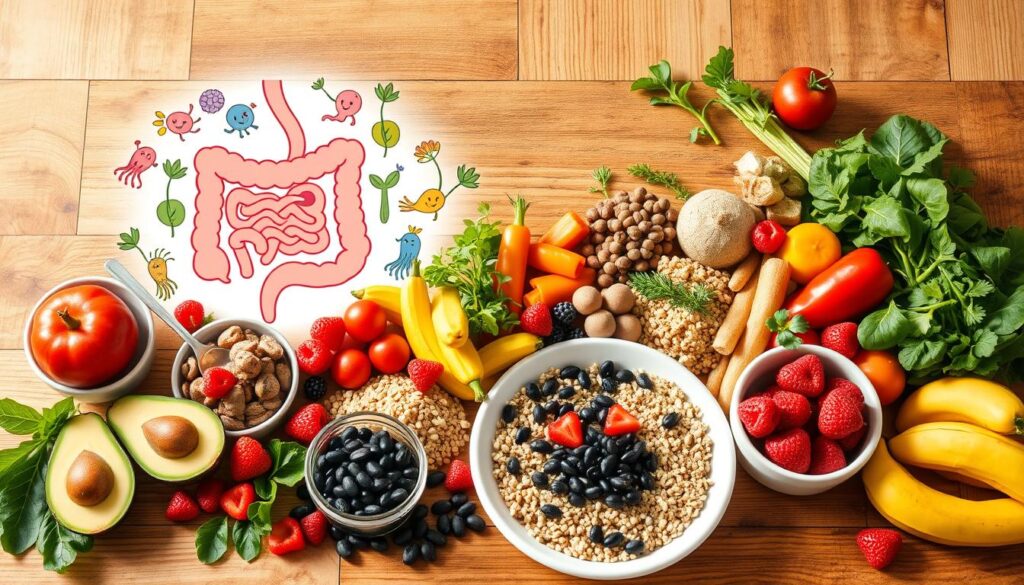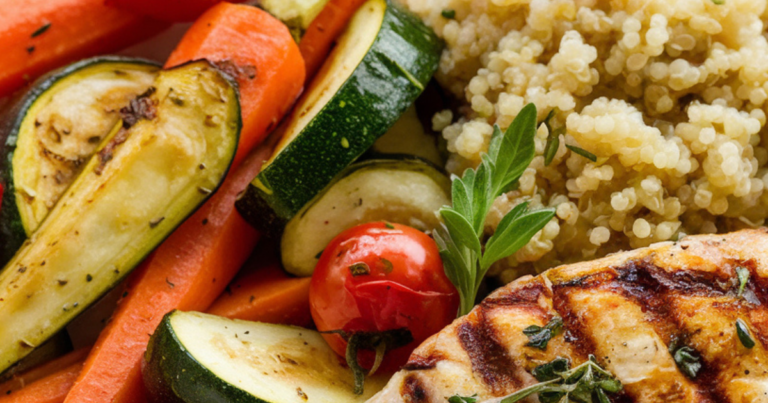High-Fiber Meal Plans: A Complete Guide for Healthy Eating
A Complete Guide for Healthy Eating
Starting a high-fiber diet can change your health for the better. This guide shows how adding fiber-rich foods to your meals can help. You’ll learn how to feed your body with nutrients, improve digestion, and keep your weight in check.
Fiber is key for a healthy diet. It helps keep your colon healthy and supports overall nutrition. This article will give you tips on making tasty, fiber-rich meals. These meals will boost your health and taste great.
Unveiling the Benefits of Fiber-Rich Diets
Adding fiber-rich foods to your diet can greatly improve your health. It helps with digestion and managing weight. Let’s explore how fiber boosts gut health and aids in weight loss.
Improved Digestion and Gut Health
Fiber is key for a healthy gut. It keeps your digestive system running smoothly. It also helps prevent constipation.
Some fibers, like soluble fiber, feed good bacteria in your gut. This supports a healthy gut microbiome.
Weight Management and Satiety
Fiber-rich foods make you feel full longer. They slow down nutrient absorption, giving you energy slowly. This reduces cravings and helps control eating.
By eating more dietary fiber, you support a healthier lifestyle. It’s a simple way to nourish your body and reach your health goals.
“Fiber is an essential component of a balanced diet, with a multitude of benefits for both your gut health and overall well-being. Embracing fiber-rich foods is a simple yet powerful way to nourish your body and support your long-term health goals.”

High-Fiber Meal Plans: An Overview
Making a high-fiber meal plan is crucial for good digestion and health. These plans include foods high in fiber from different groups. This makes it simple to get enough fiber and enjoy its many benefits.
Whole grains, fruits, vegetables, legumes, and nuts are key in these plans. They are not just high in fiber. They also have vitamins, minerals, and antioxidants that boost health.
Essential Components of High-Fiber Meal Plans
- Whole grains: Such as quinoa, oats, and brown rice, which are excellent sources of fiber, complex carbohydrates, and a range of other beneficial nutrients.
- Fruits and vegetables: Offering a diverse array of fiber-rich options, from leafy greens and berries to beans and lentils.
- Nuts and seeds: Providing a satisfying crunch while boosting fiber and protein intake.
- Lean proteins: Such as poultry, fish, and plant-based sources, which can be seamlessly incorporated into high-fiber meals.
- Healthy fats: From avocados and olive oil to nuts and seeds, which contribute to overall nutrient absorption and satiety.
By mixing these fiber-rich foods, you can make tasty, healthy meals. These meals help with digestion, weight control, and overall health. The trick is to try different recipes and find what works best for you.
“Fiber is the unsung hero of a healthy diet. It’s time to give it the recognition it deserves.”
Whole Grains: The Fiber-Rich Powerhouses
Whole grains are key for adding fiber to your diet. They are packed with nutrients like vitamins, minerals, and antioxidants. These foods support your health and well-being.
Quinoa: A Gluten-Free Superfood
Quinoa is known as a “superfood” because it’s gluten-free. It’s a complete protein, meaning it has all nine essential amino acids. This makes it great for whole food nutrition and fiber-rich diets.
It’s also full of fiber, minerals, and antioxidants. This gives you a big health boost.
Oats: A Heart-Healthy Breakfast Staple
Oats are good for your heart. They are full of soluble fiber, which can lower cholesterol. Eating oats for breakfast is a healthy way to start your day.
“Whole grains are a treasure trove of fiber, nutrients, and health benefits. Embracing them as part of a balanced, fiber-rich diet can be a game-changer for overall well-being.”
Learning about quinoa and oats can help you make better food choices. They are great for a fiber-rich diet. This can lead to a healthier, more nourishing life.
Fruits and Veggies: Nature’s Fiber Treasures
Eating a diet full of fiber-rich fruits and veggies is great for your body. It helps keep your digestive system healthy. These foods are full of dietary fiber, which helps with bowel movements and more.
Fruits like raspberries, blackberries, and pears are high in fiber, with up to 8 grams per serving. Vegetables such as broccoli, artichokes, and split peas are also packed with fiber. They are key for healthy meals.
Adding a variety of fiber-rich foods to your meals can change your life. It can improve digestion and help with weight management. The benefits of dietary fiber are huge and worth the effort.
| Fiber-Rich Fruit | Fiber Content (per serving) |
|---|---|
| Raspberries | 8 grams |
| Pears | 6 grams |
| Blackberries | 8 grams |
| Avocado | 7 grams |
By focusing on fruits and veggies, you feed your body and support a healthy gut. Enjoy the fiber-rich foods of nature. Make tasty, healthy meals that make you feel great.
“Eating a diet rich in fiber-packed fruits and veggies is one of the best ways to support a healthy digestive system and promote regular bowel movements.”
Legumes and Nuts: Protein-Packed Fiber Boosters
Legumes and nuts are key to high-fiber meal plans. They add crunch and flavor and are rich in dietary fiber.
Lentils: A Versatile and Nutrient-Dense Option
Lentils are great for many meals. They’re full of soluble fiber, which aids digestion. They’re also a good plant-based protein source, perfect for vegans and vegetarians.
Almonds: A Crunchy and Satisfying Snack
Almonds are tasty and high in fiber. They’re a great snack for boosting fiber. They also have healthy fats, vitamins, and minerals.
| Ingredient | Fiber Content (per serving) | Protein Content (per serving) |
|---|---|---|
| Lentils (1 cup, cooked) | 15.6 g | 17.9 g |
| Almonds (1 ounce, raw) | 3.5 g | 6 g |
Adding lentils and almonds to your meals boosts your diet. They’re packed with protein and fiber, supporting your health.
Conclusion
This guide has shown the many benefits of high-fiber meal plans. Eating fiber-rich diets helps with digestion, weight control, and gut health. It covered the importance of whole grains, fruits, vegetables, legumes, and nuts.
Now, you know how to make tasty, nutrient-dense meals that are good for you. By following whole food nutrition and colon-friendly meals, you can enjoy the benefits of dietary fiber. This can lead to better health and well-being.
Starting your health journey is easy with small steps. This guide has given you the tools to make high-fiber meal plans a daily habit. Let fiber be your ally for better digestion, weight, and overall health.
FAQ
What are the benefits of incorporating fiber-rich foods into my diet?
Eating foods high in fiber is good for your health. It helps with digestion and gut health. It also aids in weight management and keeps you feeling full.
How much fiber should I aim to consume daily?
The amount of fiber you need changes with age and gender. Adults should aim for 25-30 grams daily. This comes from eating a variety of whole foods.
What are some of the best high-fiber foods to include in my meal plans?
Great sources of fiber are whole grains like quinoa and oats. Legumes, such as lentils, are also good. Plus, many fruits and vegetables are high in fiber.
How can I easily incorporate more fiber into my daily meals?
Start by choosing whole grains over refined ones. Add more fruits and veggies to your meals. Also, include nuts and seeds for extra fiber. Slowly increasing your fiber intake helps your body adjust.
Are there any special considerations for individuals with digestive issues when following a high-fiber diet?
If you have digestive sensitivities, add high-fiber foods slowly. Drink lots of water to help your body adjust. Talking to a healthcare professional can offer personalized advice on fiber intake.







